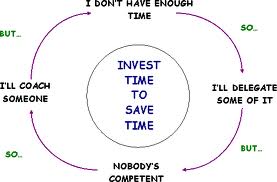Delegation skills
 Delegation is one of the most important management skills. Good delegation saves you time, develops you people, grooms a successor, and motivates. Poor delegation will cause you frustration, demotivates and confuses the other person, and fails to achieve the task or purpose itself. So it’s a management skill that’s worth improving.
Delegation is one of the most important management skills. Good delegation saves you time, develops you people, grooms a successor, and motivates. Poor delegation will cause you frustration, demotivates and confuses the other person, and fails to achieve the task or purpose itself. So it’s a management skill that’s worth improving.
Delegation is a very helpful aid for succession planning, personal development – and seeking and encouraging promotion. It’s how we grow in the job – delegation enables us to gain experience to take on higher responsibilities.
Effective delegation is actually crucial for effective succession. For the successor, and for the manager too: the main task of a manager in a growing thriving organization is ultimately to develop a successor. When this happens everyone can move on to higher things. When it fails to happen the succession and progression becomes dependent on bringing in new people from outside.
Delegation can be used to develop your people and yourself – as a giver of delegated tasks you must ensure delegation happens properly. Just as significantly, as the recipient of delegated tasks you have the opportunity to ‘manage upwards’ and suggest improvements to the delegation process and understanding – especially if your boss could use the help.
Managing the way you receive and agree to do delegated tasks is one of the central skills of ‘managing upwards’. Therefore the principles are just as useful for people being managed.
The basic steps of successful delegation
1 Define the task
 Confirm in your own mind that the task is suitable to be delegated. Does it meet the criteria for delegating?
Confirm in your own mind that the task is suitable to be delegated. Does it meet the criteria for delegating?
2 Select the individual or team
What are your reasons for delegating to this person or team? What are they going to get out of it? What are you going to get out of it?
3 Assess ability and training needs
Is the other person or team of people capable of doing the task? Do they understand what needs to be done? If not, you can’t delegate.
4 Explain the reasons
You must explain why the job or responsibility is being delegated. And why to that person or people? What is its importance and relevance? Where does it fit in the overall scheme of things?
5 State required results
What must be achieved? Clarify understanding by getting feedback from the other person. How will the task be measured? Make sure they know how you intend to decide that the job is being successfully done.
6 Consider resources required
Discuss and agree what is required to get the job done. Consider people, location, premises, equipment, money, materials, other related activities and services.
7 Agree deadlines
When must the job be finished? Or if an ongoing duty, when are the review dates? When are the reports due? And if the task is complex and has parts or stages, what are the priorities?
At this point you may need to confirm understanding with the other person of the previous points, getting ideas and interpretation. As well as showing you that the job can be done, this helps to reinforce commitment.
Methods of checking and controlling must be agreed with the other person. Failing to agree this in advance will cause this monitoring to seem like interference or lack of trust.
8 Support and communicate
Think about who else needs to know what’s going on, and inform them. Involve the other person in considering this so they can see beyond the issue at hand. Do not leave the person to inform your own peers of their new responsibility. Warn the person about any awkward matters of politics or protocol. Inform your own boss if the task is important, and of sufficient profile.
9 Feedback on results
It is essential to let the person know how they are doing, and whether they have achieved their aims. If not, you must review with them why things did not go to plan, and deal with the problems. You must absorb the consequences of failure, and pass on the credit for success.
Levels of delegation
 Delegation isn’t just a matter of telling someone else what to do. There is a wide range of varying freedom that you can confer on the other person. The more experienced and reliable the other person is, then the more freedom you can give. The more critical the task then the more cautious you need to be about extending a lot of freedom, especially if your job or reputation depends on getting a good result. Take care to choose the most appropriate style for each situation. For each example the statements are simplified for clarity; in reality you would choose a less abrupt style of language, depending on the person and the relationship. At the very least, a “Please” and “Thank-you” would be included in the requests.
Delegation isn’t just a matter of telling someone else what to do. There is a wide range of varying freedom that you can confer on the other person. The more experienced and reliable the other person is, then the more freedom you can give. The more critical the task then the more cautious you need to be about extending a lot of freedom, especially if your job or reputation depends on getting a good result. Take care to choose the most appropriate style for each situation. For each example the statements are simplified for clarity; in reality you would choose a less abrupt style of language, depending on the person and the relationship. At the very least, a “Please” and “Thank-you” would be included in the requests.
It’s important also to ask the other person what level of authority they feel comfortable being given. Why guess? When you ask, you can find out for sure and agree this with the other person. Some people are confident; others less so. It’s your responsibility to agree with them what level is most appropriate, so that the job is done effectively and with minimal unnecessary involvement from you. Involving the other person in agreeing the level of delegated freedom for any particular responsibility is an essential part of the ‘contract’ that you make with them.
These levels of delegation are not an exhaustive list. There are many more shades of grey between these black-and-white examples. Take time to discuss and adapt the agreements and ‘contracts’ that you make with people regarding delegated tasks, responsibility and freedom according to the situation.
Be creative in choosing levels of delegated responsibility, and always check with the other person that they are comfortable with your chosen level. People are generally capable of doing far more than you imagine.
The rate and extent of responsibility and freedom delegated to people is a fundamental driver of organisational growth and effectiveness, the growth and well-being of your people, and of your own development and advancement.
The 10 Levels
These examples of different delegation levels progressively offer, encourage and enable more delegated freedom. Level 1 is the lowest level of delegated freedom (basically none). Level 10 is the highest level typically (and rarely) found in organisations.
1 “Wait to be told.” or “Do exactly what I say.” or “Follow these instructions precisely.”
This is instruction. There is no delegated freedom at all.
2 “Look into this and tell me the situation. I’ll decide.”
This is asking for investigation and analysis but no recommendation. The person delegating retains responsibility for assessing options prior to making the decision.
3 “Look into this and tell me the situation. We’ll decide together.”
This is has a subtle important difference to the above. This level of delegation encourages and enables the analysis and decision to be a shared process, which can be very helpful in coaching and development.
4 “Tell me the situation and what help you need from me in assessing and handling it. Then we’ll decide.”
This is opens the possibility of greater freedom for analysis and decision-making, subject to both people agreeing this is appropriate. Again, this level is helpful in growing and defining coaching and development relationships.
5 “Give me your analysis of the situation (reasons, options, pros and cons) and recommendation. I’ll let you know whether you can go ahead.”
Asks for analysis and recommendation, but you will check the thinking before deciding.
6 “Decide and let me know your decision, and wait for my go-ahead before proceeding.”
The other person is trusted to assess the situation and options and is probably competent enough to decide and implement too, but for reasons of task importance, or competence, or perhaps externally changing factors, the boss prefers to keep control of timing. This level of delegation can be frustrating for people if used too often or for too long, and in any event the reason for keeping people waiting, after they’ve inevitably invested time and effort, needs to be explained.
7 “Decide and let me know your decision, then go ahead unless I say not to.”
Now the other person begins to control the action. The subtle increase in responsibility saves time. The default is now positive rather than negative. This is a very liberating change in delegated freedom, and incidentally one that can also be used very effectively when seeking responsibility from above or elsewhere in an organisation, especially one which is strangled by indecision and bureaucracy. For example, “Here is my analysis and recommendation; I will proceed unless you tell me otherwise by (date).”
8 “Decide and take action – let me know what you did (and what happened).”
This delegation level, as with each increase up the scale, saves even more time. This level of delegation also enables a degree of follow-up by the manager as to the effectiveness of the delegated responsibility, which is necessary when people are being managed from a greater distance, or more ‘hands-off’. The level also allows and invites positive feedback by the manager, which is helpful in coaching and development of course.
9 “Decide and take action. You need not check back with me.”
The most freedom that you can give to another person when you still need to retain responsibility for the activity. A high level of confidence is necessary, and you would normally assess the quality of the activity after the event according to overall results, potentially weeks or months later. Feedback and review remain helpful and important, although the relationship is more likely one of mentoring, rather than coaching per se.
10 “Decide where action needs to be taken and manage the situation accordingly. It’s your area of responsibility now.”
The most freedom that you can give to the other person, and not generally used without formal change of a person’s job role. It’s the delegation of a strategic responsibility. This gives the other person responsibility for defining what changes projects, tasks, analysis and decisions are necessary for the management of a particular area of responsibility, as well as the task or project or change itself, and how the initiative or change is to be implemented and measured, etc. This amounts to delegating part of your job – not just a task or project. You’d use this utmost level of delegation (for example) when developing a successor, or as part of an intentional and agreed plan to devolve some of your job accountability in a formal sense.
Resources
A FREE Mindtools Delegation Questionairre
A really useful Slide share PowerPoint presentation on Delegation skills training